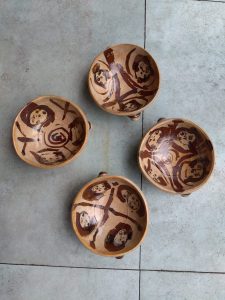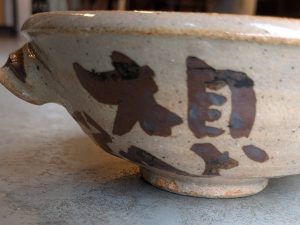帝室技芸員と人間国宝 何が違うの?(愛知県名古屋市千種区姫池通 骨董買取 古美術風光舎)
2024.07.09
みなさまこんにちは、スタッフTでございます。

さて、本日は「帝室技芸員」についてのお勉強です。
「帝室技芸員(ていしつぎげいいん)」?聞き慣れない言葉、何それ? という方もいらっしゃるかと思います。 かく言う私も、知りませんでした……。
「帝室技芸員」と言われても、何のことやら……。それも無理はありません、現在ではもう存在しない顕彰制度です。
帝室技芸員は、1890年から1947年まで帝室(皇室)によって運営されていた美術家や工芸家の顕彰制度です。
1888年(明治21年)に帝室より「宮内省工芸員」が制定され、1890年(明治23年)にそれに変わる「帝室技芸員」制度が発足されました。最初に任命されたのは高村光雲(彫刻)、石川光明(彫刻)、柴田是真(漆工)、橋本雅邦(画家)、田崎早雲(画家)、森 寛斎(画家)、狩野永悳(画家)、伊達弥助(織物)、狩野夏雄(彫金)等がいました。
この制度は、明治維新によって日本の伝統文化が低迷している中、幕府や諸藩の庇護を失い、窮地に立たされた日本美術・工芸作家の保護奨励を目的としました。その制度によって選ばれたのが帝室技芸員で、皇室の美術・工芸品制作を勅命で行ったり、博物館総長の諮問(しもん)に応じたり、といった任務が与えられた、栄誉職でした。
定員は25名で勅任官待遇を受け、年金ももらうことができ、制度が廃止された昭和19年(1944)までに79名が任命されています。
「技芸員」という名前の通り、任命された作家の分野は幅広く、日本画家や西洋画家、彫刻家のほか、金工、陶工、漆工、刀工といった諸工芸作家、写真家なども任命されており、現在の「人間国宝」制度の前身になっているともいわれています。
では「人間国宝」とは?
「人間国宝」という言葉は通称であり「重要無形文化財の各個認定保持者という認定を受けた人」ということです。物ではなく、その「技」を持つ人間のそのものを“文化財”とする名称です。
芸能では雅楽、能楽、文楽、歌舞伎、舞踊、演劇など、工芸技術では陶芸、染色、漆芸、金工、木竹工などで認定されています。
「無形」があるなら当然「有形」もあります。絵画や古美術品、建造物などがそうですね。
このような自国の芸術家を守る制度は日本のみで諸外国にはないようです。なんだか少し鼻が高い気がするのは私だけでしょうか。
現在の人間国宝が持つ「伝統文化の保護」を主目的としているのに対し、帝室技芸員は「日本の美術工芸を外国に広める」という意図があったといわれています。
とはいえ、単に「人気があるから」というだけで任命されるものではなく、任命されるに不足ない優れた技術を持つ作家が厳選されていたことは、最後に任命が行われた1944年までの55年間に、絵画 45名、彫刻7名、工芸 24名、建築2名、写真1名、計 79名しかいないことを見れば明らかです。
少し興味が湧いてきたところで、次回は「帝室技芸員」に誰がいるの?と題して、お勉強して参りたいと思います。
ではでは、また。

Hello everyone, this is Staff T.
Today, we will learn about “Imperial Household Artists.
A “Teisho Gijin” (Imperial Household Artistician)? What is this unfamiliar term? Some of you may be wondering, “What is it? I didn’t know it either. ……
Even if you say “Imperial Household Artists,” I have no idea what you are talking about: ……. It is not surprising that it is an awarding system that no longer exists today.
The Imperial Household Artists were a system of honoring artists and craftsmen that was administered by the Imperial Household (Imperial Household) from 1890 to 1947.
The purpose of the program was to protect and encourage artists of Japanese arts and crafts who had lost the patronage of the shogunate and clans and were in dire straits, while traditional Japanese culture was in a slump due to the Meiji Restoration. Under this system, Imperial Household Artists were selected for the position of Imperial Household Artists, an honorary position with duties such as producing works of art and crafts for the Imperial Household by imperial order and in consultation with the Director General of the Museums.
The number of museum curators was limited to 25, and they received imperial appointments and pensions. 79 curators were appointed until 1944, when the system was abolished.
As the name “Artist-in-Residence” implies, there were a wide range of artists appointed, including Japanese and Western painters, sculptors, goldsmiths, potters, lacquer workers, swordsmiths, and photographers, and it is said to be the forerunner of the current “Living National Treasure” system.
So what is a “Living National Treasure”?
The term “living national treasure” is a common name for a person who has been certified as an individual holder of an important intangible cultural property. It is not a physical object, but a person who possesses the “technique” that is considered a “cultural asset.
The “intangible cultural properties” are recognized in the performing arts such as gagaku, Noh, bunraku, kabuki, dance, and drama, and in the crafts such as ceramics, dyeing, lacquer, metalwork, and wood and bamboo crafts.
If there are “intangible” arts, there are naturally “tangible” arts as well. If there is an “intangible,” there is naturally a “tangible,” such as paintings, antiques, and architectural structures.
It seems that Japan is the only country that has such a system to protect its own artists, while other countries do not. Am I the only one who feels a bit proud?
It is said that the main purpose of the current Living National Treasures is to “protect traditional culture,” while the Imperial Household Artists were intended to “promote Japanese arts and crafts to foreign countries.
Nevertheless, it is clear from the fact that during the 55 years until 1944, when the last appointment was made, only 79 artists were appointed, including 45 painters, 7 sculptors, 24 craftsmen, 2 architects, and 1 photographer, rather than simply because they were “popular”. This is evident from the fact that there were only 79 artists in total.
Now that you have become a little more interested in the subject, let’s take a look at who are the “Imperial Household Artists” in the next issue of “Who are the Imperial Household Artists? I would like to learn more about the “Imperial Household Artists.
See you soon.
*******************
ご実家の整理やお片付けなどをされている方のご相談などが多くございます。
お片付けなどくれぐれもご無理のないようになさってくださいませ。
風光舎では古美術品や骨董品の他にも絵画や宝石、趣味のお品など様々なジャンルのものを買受しております。
お片付けをされていて、こういうものでもいいのかしらと迷われているものでも、どうぞお気軽にご相談下さいませ。
また風光舎は、出張買取も強化しております。ご近所はもちろん、愛知県内、岐阜県、三重県その他の県へも出張いたします。
まずは、お電話お待ちしております。
愛知県名古屋市千種区姫池通
骨董 買取【古美術 風光舎 名古屋店】
TEL052(734)8444
10:00-18:00 OPEN

